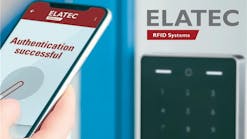Advances In Wireless: Three ways wireless has changed security
Most of the modern-day security buzz revolves around topics such as video analytics, biometrics, convergence and other relatively newer technologies that have started defining clearer roles for themselves in protection.
It’s arguable, though, that one of the biggest catalysts behind the evolution in the security industry today is a technology that has been enduring for many years. Although it’s been around for decades, it appears wireless is finally ready to reach its full potential in the security industry. And that potential carries just as great – if not, greater – implications for the future of security as any of the newer technologies listed above.
Wireless represents an opportunity to significantly enhance the effectiveness of the standard security system without breaking the bank. But the benefits of wireless go far beyond monetary savings – using today’s sensors in a strategic manner truly does strengthen overall security and asset protection.
With that in mind, here are three key benefits that illustrate how the newest wireless advancements are greatly influencing the future of security technology.
More than Intrusion
The cliché “less is more” couldn’t be more true than in the case of wireless. That’s because advances in wireless sensor technology are allowing security systems to track much more today than intruders.
Consider wireless environmental and temperature sensors, for example. When tying these technologies back to the main alarm panel, the solution can notify central stations or end users themselves of incidents that ultimately result in lost property, even if no one is trying to break in.
Many homeowners, for instance, have shown interest in flood detection technology because basements, water heaters and sump pumps are at high risk for leaks and damage. The Insurance Research Council, in fact, estimates that over 25 percent of property claims result from water-related damage – more than fire and burglary claims combined; with the majority of water damage claims from faulty indoor appliances.
As a remedy, more dealers today are prescribing flood detection sensors that can detect water with an external probe typically mounted where water would accumulate. When it detects the presence of water, the device initiates a chain of dealer-programmed events in response.
The same premise holds true for temperature sensors, which can be used to protect valuable items in both home and commercial environments by detecting significant temperature fluctuations. Due to the ease of wireless installation, these devices are ideally suited for a wide range of applications including bathrooms, kitchens, laundry rooms and basements. For example, a restaurant might elect to install a wireless temperature sensor in its refrigerator to ensure thousands of dollars of perishable food isn’t lost if the power fails in the middle of the night. In a colder-weather residential settings, where second-home owners may have vacation properties, these sensors can initiate alarms if they detect temperature drops that could potentially lead to incidents such as frozen pipes.
In either of these cases, the cost of adding the sensors greatly pales in comparison to the cost of replacing damaged assets and valuables.
Theft Prevention
For many years, organizations and homeowners have sought to protect their properties and assets by preventing break-ins. The problem with this strategy is that a significant chunk of thefts don’t occur as a result of intrusion.
Take multi-family housing developments, for instance. Earlier this year, a Texas-based housing firm sought help to combat a rash of flat-screen burglaries from its exercise rooms. According to the firm’s security dealer, Southcross Security, many of the thefts were perpetrated by residents, or friends of residents who already were inside the buildings.
For a solution, the dealer recommended the Honeywell 5870 Asset Protection Indoor (API), a sensor designed to protect individual assets that shouldn’t be in motion for very long periods of time.
The small square-shaped device represents is the industry’s first wireless sensor that utilizes an accelerometer with integrated Micro Electro-Mechanical Systems (MEMS) technology, the same technology used to deploy automobile airbags. The product easily affixes to valuables such as paintings, flat-screen TVs, jewelry box lids and other surfaces. Upon detecting motion, the sensor transmits signals to alarm panels, which can then alert monitoring stations if valuable objects that should otherwise remain in place are moved.
Southcross has found the sensor to be very effective in preventing the thefts from reoccurring. Currently, about 25 facilities managed by the firm are using the device to protect their flat screens, as well as computers located in their business centers.
“The last 12 months or so has seen a great increase in the number of flat screen TVs in public places,” said Doug Yarger, Southcross president. “It’s a candy store for thieves, which makes this device all the more timely.”
Better Outdoor Reliability
For most people, the thought of using outdoor-motion sensing for security usually evokes images of lighting systems that turn on whenever a car pulls up the driveway, or a small animal scurrying away after it unwittingly trips the device.
Today’ outdoor sensors have come a long way and are enabling far more robust functionality and much better reliability. A critical advancement in this area is the use of passive infrared (PIR) sensors to prevent nuisance alarms. Newer detectors actually use two integrated sensors that both must be tripped in order to declare an alarm. This approach allows the devices to distinguish between animals (both large and small) and humans for improved reliability.
The greater value of these enhanced devices, though, lies in their ability to integrate with the alarm panel. For example, in addition to alerting security personnel to intruders, dealers can program the device to engage CCTV cameras for better awareness. Stringing a series of these devices together also can create a virtual fence line – and at a fraction of the cost of a wired solution, which would require time-consuming trenching. This enhanced functionality makes the total solution ideal for protecting car lots, alleys, loading docks, remote garages, sheds and other structures.
Additionally, weatherproof packaging has expanded the functionality of the overall solution. Homer Creutz, owner of Heartland Security LLC in North Platte, Neb., recently performed an installation for a client needing to protect a large, low-temperature, detached building used to store a tractor. For the solution, Creutz used a weatherproof outdoor PIR device with a temperature range of (-)1 – 122 degrees Fahrenheit.
“There’s no heat in there,” Creutz said. “And, getting a hard wire out there was next to impossible.”
Remote Monitoring
The latest advancements in wireless increase a security system’s overall effectiveness by quite literally extending its reach both inside and outside. But there’s a bigger picture.
Aside from extending the security system’s reach, these devices increase the end user’s awareness of the larger environment. This is primarily due to two reasons: 1) The sensors give the system access to areas that previously were unreachable due to wiring costs and/or logistics, and 2) when tied to digital communications technology, they can feed information directly to the end users themselves, even if they aren’t physically there.
Remote-monitoring solutions such as Honeywell’s Total Connect enable alarm panels to send information to home and business owners through any web browser, including those accessed with mobile devices such as laptops, smart phones such as Blackberrys or iPhones and other cell phones. Adding new wireless technologies to the picture means the system can email alerts to homeowners for specific events such as an asset sensor detecting a jewelry box lid opening. Another scenario: a vacation-home owner using flood detection technology can be alerted from hundreds of miles away if the security system detects water accumulating. A dealer can program the system to send a text message to the owner’s cell phone, in addition to alerting a central monitoring station.
These latest advancements have incrementally improved the standard security system, and therefore also have enhanced the ability to generate additional recurring monthly revenue (RMR). By being able to inexpensively offer add-on devices such as environmental sensors, asset protection devices and outdoor PIRs, dealers have a much easier time increasing the value of each sale.
And besides building a stronger security system, these add-ons help to build a stronger dealer-client relationship, which can reduce attrition.
“By adding a product like this, we can more closely address the customer’s concerns, and that of course breeds loyalty,” Yarger said. “We like to try to make the clients more ‘sticky,’ and this product does that.”
Tom Babich and Kevin Piel are senior marketing product managers for Honeywell Security.





